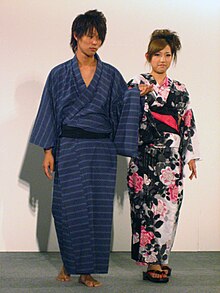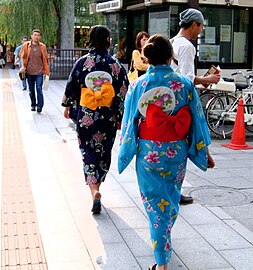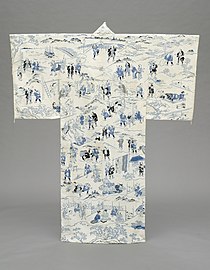
The kimono is a traditional Japanese garment and the national dress of Japan. The kimono is a wrapped-front garment with square sleeves and a rectangular body, and is worn left side wrapped over right, unless the wearer is deceased. The kimono is traditionally worn with a broad sash, called an obi, and is commonly worn with accessories such as zōri sandals and tabi socks.

There are typically two types of clothing worn in Japan: traditional clothing known as Japanese clothing, including the national dress of Japan, the kimono, and Western clothing, which encompasses all else not recognised as either national dress or the dress of another country.

Hakama are a type of traditional Japanese clothing. Originally stemming from Ku pinyin: Kù, the trousers worn by members of the Chinese imperial court in the Sui and Tang dynasties, this style was adopted by the Japanese in the form of hakama in the 6th century. Hakama are tied at the waist and fall approximately to the ankles. They are worn over a kimono specially adapted for wearing hakama, known as a hakamashita.
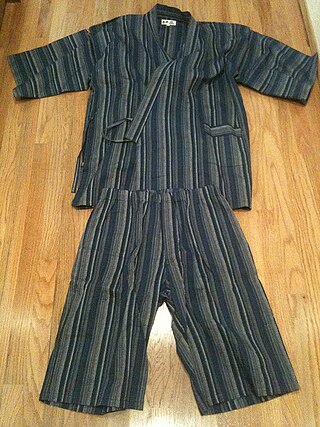
A jinbei (甚平) is a traditional set of Japanese clothing worn by men, women and children during summer as loungewear. Consisting of a side-tying, tube-sleeved kimono-style top and a pair of trousers, jinbei were originally menswear only, although in recent years women's jinbei have become popular.

A bathrobe, also known as a housecoat or a dressing gown, is a loose-fitting outer garment worn by people, often after washing the body or around a pool. A bathrobe is considered to be very informal clothing, and is not worn with everyday clothes.

An obi is a belt of varying size and shape worn with both traditional Japanese clothing and uniforms for Japanese martial arts styles. Originating as a simple thin belt in Heian period Japan, the obi developed over time into a belt with a number of different varieties, with a number of different sizes and proportions, lengths, and methods of tying. The obi, which once did not differ significantly in appearance between men and women, also developed into a greater variety of styles for women than for men.

Bandhani is a type of tie-dye textile decorated by plucking the cloth with the fingernails into many tiny bindings that form a figurative design. Today, most Bandhani making centers are situated in Gujarat, Rajasthan, Sindh, Punjab region and in Tamil Nadu where it is known as Sungudi. It is known as chunri in Pakistan. Earliest evidence of Bandhani dates back to Indus Valley civilization where dyeing was done as early as 4000 B.C. The earliest example of the most pervasive type of Bandhani dots can be seen in the 6th century paintings depicting the life of Buddha found on the wall of Cave at Ajanta. Bandhani is also known as Bandhej Saree, Bandhni, Piliya, and Chungidi in Tamil and regional dialects. Other tying techniques include Mothra, Ekdali and Shikari depending on the manner in which the cloth is tied. The final products are known with various names including Khombi, Ghar Chola, Patori and Chandrokhani.

A dressing gown, housecoat or morning gown is a robe, a loose-fitting outer garment, worn by either men or women. They are similar to a bathrobe but without the absorbent material.

A furisode is a style of kimono distinguishable by its long sleeves, which range in length from 85 cm (33 in) for a kofurisode, to 114 cm (45 in) for an ōfurisode. Furisode are the most formal style of kimono worn by young unmarried women in Japan.
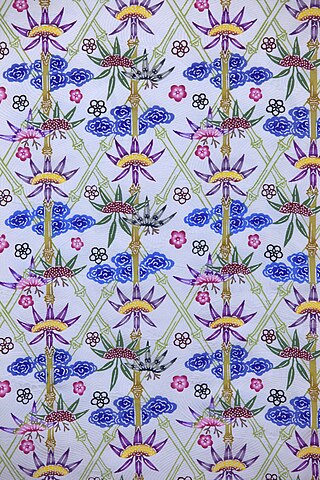
Bingata is a traditional stencilled resist dyeing technique originating in Okinawa Prefecture. Bingata typically features a busy pattern of repeating nature motifs such as fish, flowers and fauna in a number of bright colours. Bingata is worn during traditional Ryukyuan festivals and traditional arts performances.

The kosode was a type of short-sleeved Japanese garment, and the direct predecessor of the kimono. Though its component parts directly parallel those of the kimono, its proportions differed, typically having a wider body, a longer collar and narrower sleeves. The sleeves of the kosode were typically sewn to the body entirely, and often featured heavily rounded outer edges.

Boro (ぼろ) are a class of Japanese textiles that have been mended or patched together.

Yūzen (友禅) is a Japanese resist dyeing technique where dyes are applied inside outlines of dyed or undyed rice-paste resist, which may be drawn freehand or stencilled; the paste keeps the dye areas separated. Originating in the 17th century, the technique became popular as both a way of subverting sumptuary laws on dress fabrics, and also as a way to quickly produce kimono that appeared to be painted freehand with dyes. The technique was named after Miyazaki Yūzen (宮崎友禅), a 17th century fan painter who perfected the technique. Miyazaki Yūzen's fan designs became so popular that a book called the yūzen-hiinagata was published in 1688, showing similar patterns applied to kosode. A fashion for elaborate pictorial yūzen designs lasted until 1692.
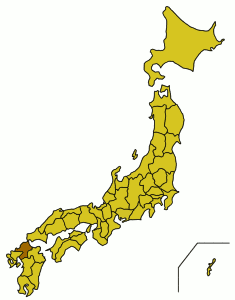
Hakata-ori (博多織) is a traditional Japanese textile that has been produced in Fukuoka Prefecture for more than 770 years.

The Khalili Collection of Kimono is a private collection of more than 450 Japanese kimono assembled by the British scholar, collector and philanthropist Nasser D. Khalili. It is one of eight collections assembled, published and exhibited by Khalili, each of which is considered to be among the most important collections within their respective fields.

Japanese clothing during the Meiji period (1867–1912) saw a marked change from the preceding Edo period (1603–1867), following the final years of the Tokugawa shogunate between 1853 and 1867, the Convention of Kanagawa in 1854 – which, led by Matthew C. Perry, forcibly opened Japanese ports to American vessels, thus ending Japan's centuries-long policy of isolation – and the Meiji Restoration in 1868, which saw the feudal shogunate dismantled in favour of a Western-style modern empire.

A tanmono is a bolt of traditional Japanese narrow-loomed cloth. It is used to make traditional Japanese clothes, textile room dividers, sails, and other traditional cloth items.

A nemaki is a tube-sleeved, unisex Japanese robe worn by guests at traditional Ryokan inns, hot spring resorts and spas. It is similar to the yukata in appearance, differing in its unisex sleeve construction, and is typically worn with a thin, unisex obi.
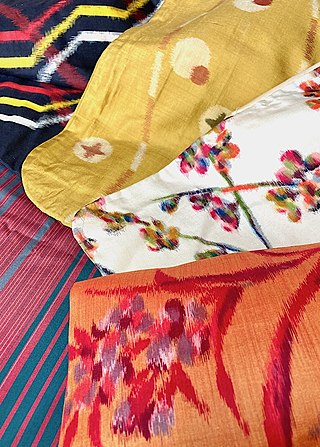
Meisen is a type of silk fabric traditionally produced in Japan; it is durable, hard-faced, and somewhat stiff, with a slight sheen, and slubbiness is deliberately emphasised. Meisen was first produced in the late 19th century, and became widely popular during the 1920s and 30s, when it was mass-produced and ready-to-wear kimono began to be sold in Japan. Meisen is commonly dyed using kasuri techniques, and features what were then overtly modern, non-traditional designs and colours. Meisen remained popular through to the 1950s.
